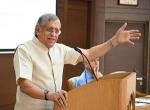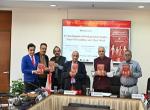The Vivekananda International Foundation (VIF) organised a Brainstorming Session on ‘India and West Asia – a New Paradigm Shift and Policy Options’. The deliberations broadly focussed on assessing the present situation in the West Asian Region especially after a spike in US-Iran tensions. Discussions were held on the impact on India in terms of energy security, Indian diaspora and security and policy options for India.
Dr Arvind Gupta, Director, VIF delivered the opening remarks followed by a brief lecture on the current situation in the West Asian states by Amb. Anil Trigunayat. The discussants included Prof. Harsh Pant from ORF, Prof. Sreeram Sundar Chaulia from Jindal School of International Affairs, Prof. P.R. Kumaraswamy from Centre for West Asian Studies, Jawaharlal Nehru University, Amb. Sanjay Singh, Dr Meena Singh Roy from Institute for Defence Studies and Analysis and Dr B. Bala Bhaskar, Joint Secretary, Ministry of External Affairs.
The discussion concluded that India required a re-examination of the central premises in framing its West Asia policy. India’s diplomatic overtures with regional organisations should be nurtured, but it should also engage with informal coalitions such as Qatar, Turkey, Iran and Russia as well as Saudi Arabia, UAE, Israel and Egypt coalition. India, in order to maintain its relevance in the region, needs to solidify engagement on all levels, i.e., political, economic, academic, cultural, trade, defence and cyber-security. In terms of diplomatic overtures, India should appoint a special envoy as well as build a team of imminent personalities comprising of security experts and diplomats that could engage in informal engagement to set the priorities and address its interests to the West Asian states. There is also a need to generate expertise and create specialists with in-depth knowledge of the region which could be appointed in the External Affairs Ministry and research think-tanks. On a multilateral level, India-West Asia summits could be organised to deepen engagement and it could participate in multi-lateral peace initiatives and offer its expertise in conflict resolution.
India has historically dealt with the region through a Pakistani prism which needs to be detached. With regard to Israel, India had maintained its policy through the lens of its support for the Palestinian cause. However, economic dividends have presently dominated India’s policy and it has benefitted greatly from its relationship with Israel. India must also grab the opportunity to participate in post-war reconstruction in Syria and engage in capacity-building exercises in training civil servants, imparting knowledge on the electoral process and parliamentary procedure and infrastructure development. It should also take advantage of India’s cultural assets which could be used as soft power.
In the naval sphere, the Strait of Hormuz and the surrounding Gulf region is already one of the most highly militarised regions of the world. Iran seems to avoid direct war and does not intend to offer excuses to the US to launch a military expedition against it. India, in order to secure its interests, has deployed two ships; it, however, requires a more prompt strategy. The Persian Gulf Region has emerged as a regional battleground which may have the collateral impact of Indian migrants working there. India must be prepared to safeguard its diaspora and secure its maritime routes. The Chabahar Port is seen as a symbol of protecting India’s economic space. It must ensure that the dependency on energy from the region should come down to below 50 per cent. It should also develop a strategic petroleum reserve.
The discussion concluded that the states in the region are presently articulating their own position and pushing their boundaries in the regional strategic architecture. Subsequently, there is a need for India to articulate its own extended boundary from South East Asia to East Africa. These reassessments would facilitate India’s plans to become an active member of the blue economy.







Post new comment